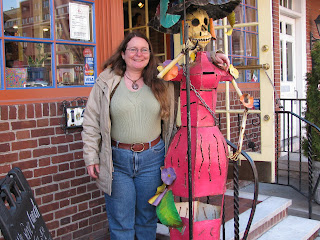I made this pretty pounded cuff bracelet from a very plain wide cuff blank and just a hammer, steel block, pliers and with the metal bits and pieces laying around my bead board.
You could make one using your own design of course by using a piece of sheet metal you cut yourself or a metal cuff blank made flat.
I like raw brass or copper because these take a patina but you can use any metal and experiment.
First take cuff blank and flatten it a little by bending it. Don't flatten using a hammer because you are going to make it cuff shaped again.
You are going to lay your metal cuff blank on top of your steel block and put pieces of metal between your blank and the block. These have to be reasonably flat or they will slide around when you start hammering. You don't want them to slide because you want nice print in the metal and not a distorted one.
I used several flat brass heshi beads, washers, and 12 gauge brass wire twisted into the shapes I wanted. You place your little metal objects one piece at a time under the bracelet blank on the side that will face outward when you finally bend it back into a bracelet, and hold the blank firm and still while you hammer directly on top of your little metal thing.
You want to hit hard enough to see a dent make a raised form on the place you are hitting the hammer. That's how you know you hit hard enough. Move your pieces around and check your impressions as you go so you can see what you like. Experiment with very hard hits and some softer ones. You can use pennies and other small coins. Hardware like little flat nuts or the heads snipped from screws would look good too. Don't use anything that will shatter. Don't use rocks, glass or gemstones. Use protective eye wear and keep your fingers away from the sharp edges of your sheet metal.
Don't try too hard to make a definite design. Plan you design with flexibility because since you are doing this by hand the pieces slip a little sometimes and the dents are not perfect. My design looks a little like curling vines and I am sure my next cuff will look very different.
When you are finished with your design turn the blank over and add dents, shapes or texture by hitting it directly on the good side. You could add scratches with a nail or your dremel tool if you want.
Finish the bracelet by bending it back into a cuff again with your hands. I like to bend the edges on mine with a pair of pliers but you leave yours flat or use what ever method you want to finish the edges. I pound the edges to thicken them and also to work harden the shape of the cuff.
The edges on my cuff are pounded hundreds of times so they are thicker than when I first started and smoothed with my dremel tool. They don't have that cut feeling. The cuff is held on the bottom edge on the block while you hit the top edge. I shape the cuff with my hand and set it on my block in the "c" shape and pound the edges. This is very very noisy! It takes a long time and my edges would be thinker a little more if I would have done this longer.
A lot of work went into this bracelet as well as punishment to the family and neighbors with the pounding noise.
Finally I removed any sharpness with my dremel tool and felt around the edges for any places that might snag. I applied a light patina with liver of sulfur and it was so vivid with color I decided to leave it that way. It's sealed with Renaissance Wax on the inside and out.
This cuff is very wide at 3" and will fit up to a 7" wrist. I can make a thinner one by special request.




